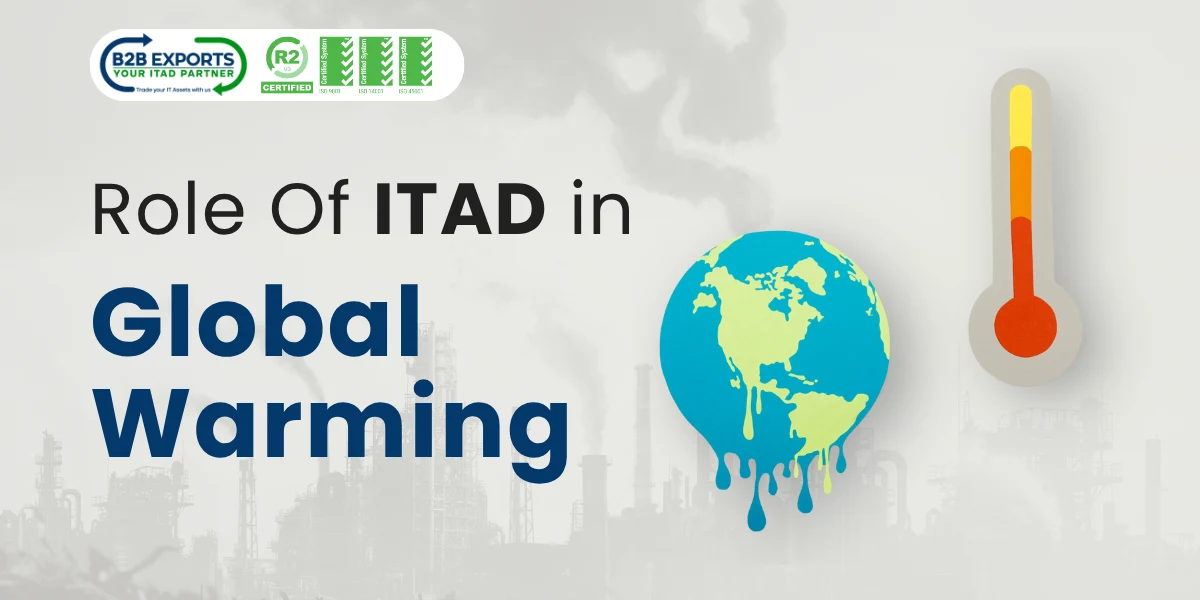Role Of ITAD in Global Warming

Global warming is one of the most critical problems at present. It causes high temperatures, rising sea level, extreme weather, biodiversity loss and risks to food & health. Multiple industries such as Agriculture, Energy Industry, Construction and Transportation have been a major cause for global warming. The IT sector is no less, if not handled properly, it also heavily increases global warming. With the increasing digital transformation, demand for IT assets has been constantly increasing. These IT assets increase e-waste, if not handled properly. Further, this increases global warming and has adverse effects on the environment.
IT Asset Disposition is a process of disposing of outdated assets, in an environmentally safe manner. It helps prevent assets from going into waste and minimizes environmental effects. It uses recycling, refurbishing and remarketing through which outdated IT assets such as computers, servers, storage devices and other IT assets are repurposed, reducing electronic waste and mitigating global warming.
E-waste and Global Warming:
When IT assets are not handled properly and thrown away in the landfills, then these assets are turned out into e-waste/electronic waste. These IT assets are heavily used and discarded in large quantities, increasing e-waste. A study reveals that over 50 million metric tons of e-waste are generated annually and the numbers are increasing year by year. This is a major cause of global warming increasing climate changes, sea levels and global temperatures. Improper disposal of outdated assets often leads to two major environmental changes:
1. Greenhouse Gas Emissions from Landfills:
When electronic devices are not handled properly or end up going to waste in the landfills, harmful substances such as plastic and metals break down, releasing greenhouse gases and other harmful chemicals which directly contribute to global warming.
2. Increased Energy Demand for New Production:
The manufacturing of new devices requires mining raw materials, processing materials and large-scale industrial production. All this releases a lot of carbon emission which directly contributes to global warming. For example, manufacturing a single laptop can release hundreds of kilograms of CO2.
Read more: Complete Guide for IT Asset Disposition
How ITAD Addresses These Key Environmental Issues
ITAD reduces the need for new production by repurposing the outdated assets, which lowers carbon emissions and helps mitigate global warming to some extent. It helps maximize the life of IT assets, reducing the need for manufacturing new production and significantly contributing to environmental protection.
How ITAD reduces Carbon Footprint:
ITAD helps reduce carbon footprint in several ways:
1. Recycling and Material Recovery:
ITAD helps in recycling and recovering useful materials such as gold, aluminum and copper from retired assets. Recycling these materials reduces the need for mining to some extent which is energy saving and contributes significantly to carbon emissions.
2. Refurbishment and Reuse:
Refurbishment helps in repurposing the assets that are still useful and hold some value. This helps increase asset lifecycle and maximize its utilization. When assets are reused, the need for manufacturing a new one is reduced which reduces carbon emissions.
3. Energy savings in Data Centers:
ITAD helps in decommissioning outdated data centers, including large servers, Storage devices and networking equipment. It helps by removing data centers that are no longer operational but are still consuming energy. This way, companies can reduce carbon emissions.
4. Waste Diversion from Landfills:
ITAD helps protect outdated IT assets from going into landfills and ending up as waste. It helps responsibly dispose of the assets by reusing, recycling and performing Data Destruction. This way, ITAD prevents the release of harmful gases from outdated assets and reduces carbon emissions.
How ITAD supports a greener future:
When IT assets reach the end of their life, discarding them is not the right choice always. ITAD provides a way to repurpose these outdated IT assets by refurbishing and reusing. This is a smarter way of retiring outdated IT assets by providing a new life to them.
When assets are no longer operational, ITAD helps organizations to repurpose these assets either by refurbishing them or recycling their useful materials. Refurbishing gives a second life to the assets, organizations can reuse these assets or resell them through IT Asset Remarketing. If the assets cannot be reused, useful materials such as gold, copper, aluminum and other earth components are extracted from them and used for other purposes.
This approach helps repurpose the outdated assets and prevents them from going to waste in the landfills. ITAD provides a way to minimize the manufacturing of new IT equipment by repurposing these assets either by reselling or reusing them within the organization. Moreover, ITAD helps save costs for businesses and generate revenue by reselling refurbished IT equipment, while recycling reduces disposal costs. In this way, ITAD successfully contributes to environmental sustainability and supports a greener future.
Read more: A Complete Guide to IT Data Destruction
Corporate Responsibility and ITAD:
Sustainability is a responsible priority and contributes significantly to a greener future. Companies are adopting practices that follow green initiatives. ITAD focuses primarily on contributing to a sustainable environment by following ecofriendly disposition methods. ITAD helps organizations support:
Environmental Goals:
ITAD supports environmental goals by allowing companies to reduce their carbon footprint and e-waste by following ecofriendly practices.
Compliance:
ITAD maintains compliance with industry recognized standards for data security, helping organizations to avoid heavy fines.
Brand Reputation:
A responsible ITAD helps strengthen the company's brand value by following strict regulations and showing a commitment to the environment.
Challenges in Implementing Sustainable ITAD:
Although ITAD provides multiple benefits, implementing an effective ITAD strategy might be a challenge for many organizations. Challenges in implementing effective ITAD involve:
Lack of Awareness:
Many organizations are unaware of the effects of improper IT asset disposal. Thus, keep on disposing of assets improperly.
Informal Recycling Practices:
Many organizations keep using traditional recycling practices, leading to increased e-waste and pollution.
Not Choosing a Certified Provider:
Many organizations fail to choose the right ITAD services provider and end up with ineffective ITAD.
Regulatory Gaps:
Not all countries have strict data security laws, allowing organizations to continue improper practices.
ITAD and the Fight Against Global Warming:
ITAD is making a positive contribution to the environment and will continue to do so in the future. With growing awareness of climate change and Global warming, ITAD is gaining importance across all industries. Let's explore the points shaping ITAD's future in Global Warming:
Technological Innovations:
There are many new inventions in recycling including AI driven innovations. This will help to make ITAD more efficient and allow for less resource usage.
Growing ESG Focus:
As companies are trying to be more ecofriendly, they are integrating ITAD into their plan and supporting sustainability goals.
Regulatory Push:
Governments are making strict regulations for data security and environmental sustainability, encouraging companies to adopt sustainable ITAD.
Sustainable IT Practices:
Many organizations are adopting sustainable IT practices. They often Reuse and refurbish IT assets to support sustainability.






